
|
High angular resolution @ MPIA |
DR /
FringetrackingDR.Fringetracking HistoryHide minor edits - Show changes to markup June 17, 2010, at 11:36 CET
by -
Added lines 21-22:
Another way to read in groupdelay.fits data is to use Changed lines 44-45 from:
A larger value smoothes over more frames, i.e. over more time. So it is only appropriate when weather conditions were good so that the frames that are smoothed together are within a coherence time. Here, one can see that the larger value of gsmooth has not affected the calibrator data too much, but in the science source almost nothing is left. check... to:
A larger value smoothes over more frames, i.e. over more time. So it is only appropriate when weather conditions were good so that the frames that are smoothed together are within a coherence time. Here, one can see that the larger value of gsmooth has not affected the calibrator data too much, but in the science source almost nothing is left. June 17, 2010, at 11:31 CET
by -
Changed lines 28-31 from:
The upper plot is the calibrator star, the lower one a faint science source: In the calibrator star there are only two lines: a more or less straight one that corresponds to the correct OPD and a sawtooth one that moves twice as fast as the instrumental delay. In the science image there are three lines: A very faint more or less straight line that is again the correct OPD and two sawtooth lines. The one with the greater angle towards the straight one is the one that corresponds to twice the intrumental delay. The one in between that is the brightest one here, corresponds to the sky signal. This signal is uncorrelated and thus by rotating it by -d_{ins} (i.e. what oirRotateInsOpd does) it appears as a signal that varies with d_{ins}. While data has already been smoothed at this step in midipipe (gsmooth has been applied), the data that is read in with oirgetdata (see above) is not yet smoothed (WHY!?). To do this by hand, call to:
The upper plot is the calibrator star, the lower one a faint science source: In the calibrator star there are only two lines: a more or less straight one that corresponds to the correct OPD and a sawtooth one that moves twice as fast as the instrumental delay. In the science image there are three lines: A very faint more or less straight line that is again the correct OPD and two sawtooth lines. The one with the greater angle towards the straight one is the one that corresponds to twice the intrumental delay. The one in between that is the brightest one here, corresponds to the sky signal. This signal is uncorrelated and thus by rotating it by -d_{ins} (i.e. what oirRotateInsOpd does) it appears as a signal that varies with d_{ins}. The signal that moves with twice the instrumental delay is also the true signal that has been modulated with the d_{ins}. The reason for this lies in the details of beam combination in MIDI: It produces a groupdelay peak at positive and one at negative delays. When subtracting (derotating) the instrumental OPD from both, one becomes a straight line and the other one is seen as a peak that varies twice as fast as the original modulation. A few more technical details on this can be found in Walter's description of oirGroupDelay. While the data has already been smoothed at this step in midipipe (gsmooth has been applied), the data that is read in with oirgetdata (see above) is not yet smoothed. To do this by hand, call July 16, 2008, at 17:57 CET
by -
Changed line 6 from:
to:
Changed line 10 from:
plot,fringes[1000:1800].localopd[0],xstyle=4,ystyle=4,/noerase@] to:
plot,fringes[1000:1800].localopd[0],xstyle=4,ystyle=4,xmargin=[0,0],/noerase@] July 16, 2008, at 12:01 CET
by -
Changed lines 35-36 from:
The top image is the smoothed calibrated, the lower one the smoothed science source. The value for smoothing (gsmooth) was 4 (default). One can see that the wrong OPD information has been very nicely removed from the calibrator star. But in the science source the sky signal dominates and therefore some sky signal remains that might distract the fringe tracking algorithm. to:
The top image is the smoothed calibrator, the lower one the smoothed science source. The value for smoothing (gsmooth) was 4 (default). One can see that the wrong OPD information has been very nicely removed from the calibrator star. But in the science source the sky signal dominates and therefore some sky signal remains that might distract the fringe tracking algorithm. Changed lines 44-46 from:
But there is a better way of getting rid of the sky background: The so treated science data then looks like this: to:
But there is a better way of getting rid of the sky background: The Changed line 49 from:
After smoothing with the default value of gsmooth = 4 one gets: to:
After smoothing with the default value ( Changed line 52 from:
For gsmooth = 10 it looks like this: to:
For Changed line 55 from:
And for gsmooth = 20 it looks like this: to:
And for July 16, 2008, at 11:27 CET
by -
Changed lines 67-69 from:
For this, the fringe tracker picks the brightest spot next to the 0 position. One can clearly see the difference between the science and the calibrator source: Whereas the delay could be easily and steadily determined for the calibrator source (upper image), the delay plot of the weak science source has many jumps, indicating that the delay could not be determined reliably for every frame. We can also overplot the delay the fringe tracker found over the Fourier transformed group delay to make clear when and why the fringe tracker could not find the correct groupdelay: to:
For this, the fringe tracker picks the brightest spot. One can clearly see the difference between the science and the calibrator source: Whereas the delay could be easily and steadily determined for the calibrator source (upper image), the delay plot of the weak science source has many jumps, indicating that the delay could not be determined reliably for every frame. We can also overplot the delay the fringe tracker found over the delay function to make clear when and why the fringe tracker could not find the correct groupdelay: 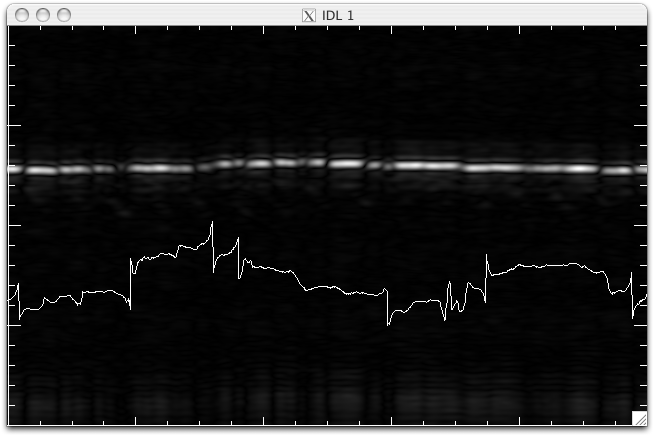 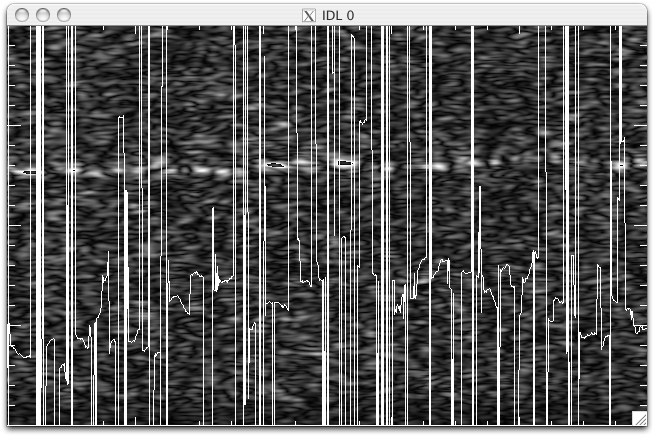 The above was produced using d=oirgetdelay('sci.groupdelay.fits')
gd1=oirgetdata('sci.groupdelay.fits')
gd2=pseudocomplex(gd1.data1)
gd2s=csmooth2(gd2,5)
tv,0.01*rebin(abs(gd2s[1000+indgen(1000),*]),1000,512)
plot,-d.delay,xr=[1000,2000],/noerase,charsize=0.01,yr=[-100,100]
Here we only plotted a 1000 pixel wide segment of the fringe track. You can see again that, for the science source (lower image), the signal/noise is bad in many frames (i.e. columns) and the OPD position that the fringe tracker returned has many jumps or spikes. For the calibrator (upper image) on the other hand the found OPD position is in most parts a smooth line. The y range of both plots is [-100 Ám, +100 Ám]. July 15, 2008, at 16:40 CET
by -
Changed line 69 from:
We can also overplot the to:
We can also overplot the delay the fringe tracker found over the Fourier transformed group delay to make clear when and why the fringe tracker could not find the correct groupdelay: July 15, 2008, at 16:35 CET
by -
Changed lines 64-66 from:
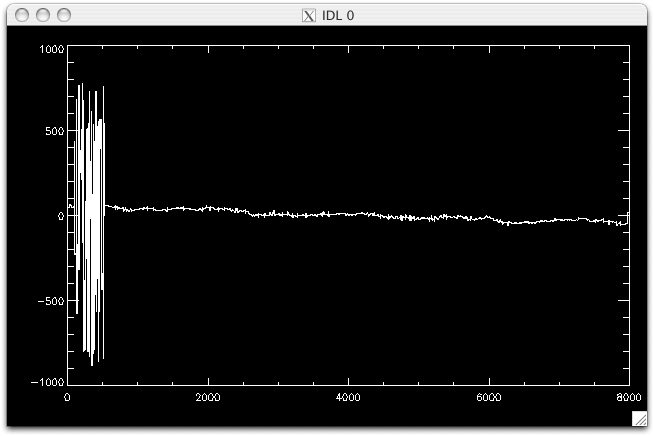 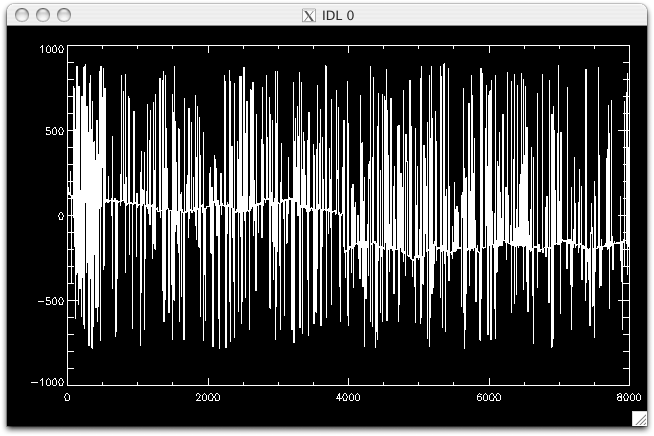 to:
  July 15, 2008, at 16:34 CET
by -
Changed lines 56-69 from:
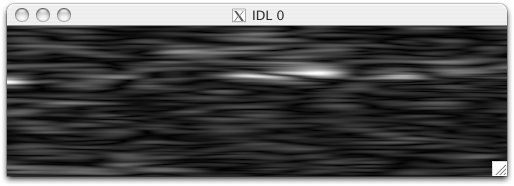 to:
 From this exercise we see that the Signal to Noise ratio for this particular science observation was not very good: There are many places where the signal is not visible over the background. Next, we can plot the delay that the fringe tracker has found from the above result:d = oirgetdelay('tag.groupdelay.fits')
dd=reform(d.delay)
dd=dd-median(dd)
Attach:groupdelay_cal_dave.jpg Δ 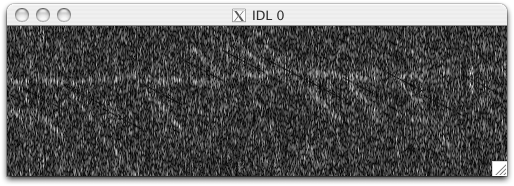 For this, the fringe tracker picks the brightest spot next to the 0 position. One can clearly see the difference between the science and the calibrator source: Whereas the delay could be easily and steadily determined for the calibrator source (upper image), the delay plot of the weak science source has many jumps, indicating that the delay could not be determined reliably for every frame. We can also overplot the July 15, 2008, at 14:35 CET
by -
Added lines 52-54:
For gsmooth = 10 it looks like this: 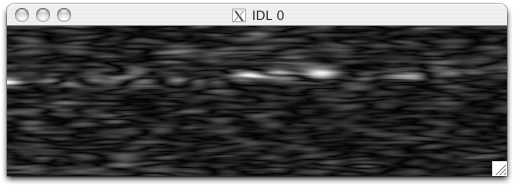 July 15, 2008, at 14:32 CET
by -
Changed lines 49-50 from:
And after smoothing with the default value of gsmooth = 4 one gets: 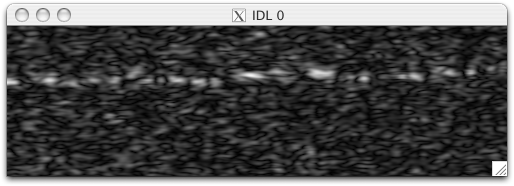 to:
After smoothing with the default value of gsmooth = 4 one gets:  And for gsmooth = 20 it looks like this:  July 15, 2008, at 12:03 CET
by -
Changed lines 42-50 from:
explain dave, ... to:
A larger value smoothes over more frames, i.e. over more time. So it is only appropriate when weather conditions were good so that the frames that are smoothed together are within a coherence time. Here, one can see that the larger value of gsmooth has not affected the calibrator data too much, but in the science source almost nothing is left. check... But there is a better way of getting rid of the sky background: The so treated science data then looks like this:  And after smoothing with the default value of gsmooth = 4 one gets:  July 15, 2008, at 11:38 CET
by -
Changed lines 28-33 from:
The upper plot is the calibrator star, the lower one a faint science source: In the calibrator star there are only two lines: a more or less straight one that corresponds to the correct OPD and a sawtooth one that moves twice as fast as the instrumental delay. In the science image there are three lines: A very faint more or less straight line that is again the correct OPD and two sawtooth lines. The one with the greater angle towards the straight one is the one that corresponds to twice the intrumental delay. The one in between that is the brightest one here, corresponds to the atmospheric delay. [after smoothing...?] While data has already been smoothed at this step in midipipe (gsmooth has been applied), the data that is read in with oirgetdata (see above) is not yet smoothed. To do this by hand, call to:
The upper plot is the calibrator star, the lower one a faint science source: In the calibrator star there are only two lines: a more or less straight one that corresponds to the correct OPD and a sawtooth one that moves twice as fast as the instrumental delay. In the science image there are three lines: A very faint more or less straight line that is again the correct OPD and two sawtooth lines. The one with the greater angle towards the straight one is the one that corresponds to twice the intrumental delay. The one in between that is the brightest one here, corresponds to the sky signal. This signal is uncorrelated and thus by rotating it by -d_{ins} (i.e. what oirRotateInsOpd does) it appears as a signal that varies with d_{ins}. While data has already been smoothed at this step in midipipe (gsmooth has been applied), the data that is read in with oirgetdata (see above) is not yet smoothed (WHY!?). To do this by hand, call Added lines 35-41:
The top image is the smoothed calibrated, the lower one the smoothed science source. The value for smoothing (gsmooth) was 4 (default). One can see that the wrong OPD information has been very nicely removed from the calibrator star. But in the science source the sky signal dominates and therefore some sky signal remains that might distract the fringe tracking algorithm. Of course one can try a larger value of gsmooth, e.g. gsmooth = 20:  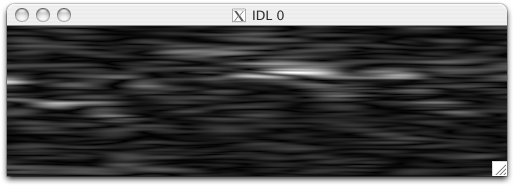 July 15, 2008, at 11:27 CET
by -
Changed lines 34-36 from:
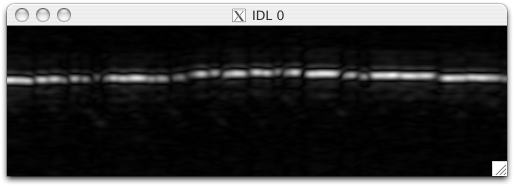 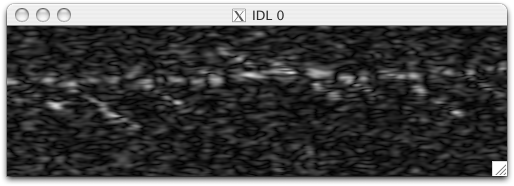 to:
  July 15, 2008, at 11:27 CET
by -
Changed lines 28-31 from:
The left plot is the calibrator star, the right one a faint science source: In the calibrator star there are only two lines: a more or less straight one that corresponds to the correct OPD and a sawtooth one that moves twice as fast as the instrumental delay. In the science image there are three lines: A very faint more or less straight line that is again the correct OPD and two sawtooth lines. The one with the greater angle towards the straight one is the one that corresponds to twice the intrumental delay. The one in between that is the brightest one here, corresponds to the atmospheric delay. [after smoothing...?] to:
The upper plot is the calibrator star, the lower one a faint science source: In the calibrator star there are only two lines: a more or less straight one that corresponds to the correct OPD and a sawtooth one that moves twice as fast as the instrumental delay. In the science image there are three lines: A very faint more or less straight line that is again the correct OPD and two sawtooth lines. The one with the greater angle towards the straight one is the one that corresponds to twice the intrumental delay. The one in between that is the brightest one here, corresponds to the atmospheric delay. [after smoothing...?] Changed lines 35-36 from:
to:
 July 15, 2008, at 11:01 CET
by -
Changed lines 22-23 from:
The above plot has been created with the command to:
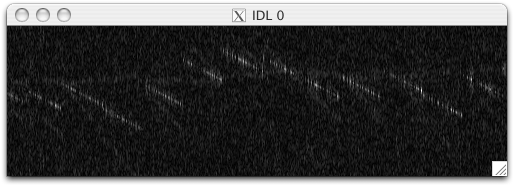 The above plots have been created with the command Added lines 28-31:
The left plot is the calibrator star, the right one a faint science source: In the calibrator star there are only two lines: a more or less straight one that corresponds to the correct OPD and a sawtooth one that moves twice as fast as the instrumental delay. In the science image there are three lines: A very faint more or less straight line that is again the correct OPD and two sawtooth lines. The one with the greater angle towards the straight one is the one that corresponds to twice the intrumental delay. The one in between that is the brightest one here, corresponds to the atmospheric delay. [after smoothing...?] July 15, 2008, at 10:50 CET
by -
Changed lines 27-45 from:
MIA+EWS> help,gd,/str ** Structure <21b8604>, 14 tags, length=4188, data length=4182, refs=1: FRAME LONG Array[1] TIME DOUBLE Array[1] EXPTIME FLOAT Array[1] OPT_TRAIN INT Array[2] REFERENCE INT Array[1] OPD DOUBLE Array[2] LOCALOPD DOUBLE Array[2] OFFSET FLOAT Array[2] ROTATION FLOAT Array[1] STEPPING_PHASE INT Array[1] DATA1 FLOAT Array[1024] TARGET1 INT Array[1] TARTYP1 STRING Array[1] INS_TRAIN INT Array[2] Here, [@opd to:
While data has already been smoothed at this step in midipipe (gsmooth has been applied), the data that is read in with oirgetdata (see above) is not yet smoothed. To do this by hand, call  explain dave, ... July 14, 2008, at 17:05 CET
by -
Changed lines 19-20 from:
to:
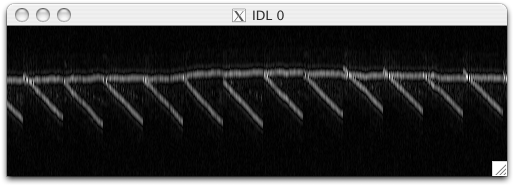 The above plot has been created with the command window,0,xsize=500,ysize=150 tvscl,abs(gd2cal[1024:1548,160:310]) July 14, 2008, at 16:28 CET
by -
Changed line 5 from:
to:
Changed lines 12-14 from:
to:

July 14, 2008, at 15:55 CET
by -
Changed lines 11-12 from:
to:
 July 14, 2008, at 15:49 CET
by -
Added lines 1-31:
Questions addressed: How well did the fringe tracking work? How good is my Signal-to-Noise? Which options should I use for weak sources? Exercise (based on instructions by WJ on 11/7/08):
MIA+EWS> help,gd,/str ** Structure <21b8604>, 14 tags, length=4188, data length=4182, refs=1: FRAME LONG Array[1] TIME DOUBLE Array[1] EXPTIME FLOAT Array[1] OPT_TRAIN INT Array[2] REFERENCE INT Array[1] OPD DOUBLE Array[2] LOCALOPD DOUBLE Array[2] OFFSET FLOAT Array[2] ROTATION FLOAT Array[1] STEPPING_PHASE INT Array[1] DATA1 FLOAT Array[1024] TARGET1 INT Array[1] TARTYP1 STRING Array[1] INS_TRAIN INT Array[2] Here, [@opd |